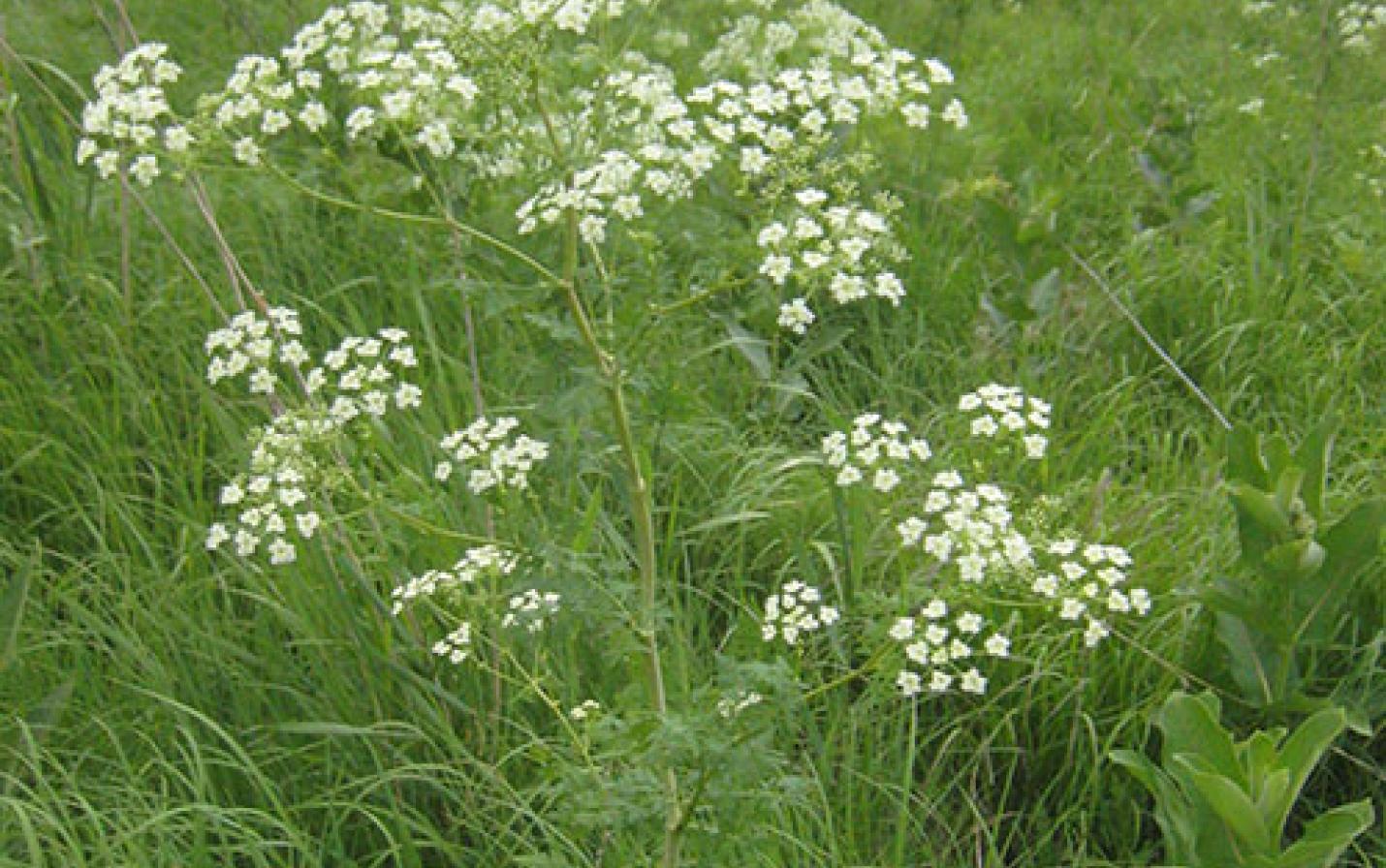
Poison Hemlock (Conium maculatum) is a relatively rare invasive plant that is quickly expanding in various parts of Crawford County. The purpose of this article is to encourage landowners to take note, and take action to minimize the spread of this species before it’s too late.
True to its name, the primary concern surrounding poison hemlock is that it is potentially lethally poisonous to people and livestock. People have been hospitalized just by being exposed to the plant, without directly consuming it, while horses and cattle have been killed when this species makes its way into hayfields, and is subsequently harvested and fed to livestock.
Whether you intend to manage this species or not, knowledge of this species on your property can help you keep you, your family, and your animals safe.
As a member of the carrot family, the shape of the flowers and plants resembles other members of the family such as Queen-Anne’s lace and wild parsnip. Unlike parsnip, poison hemlock has white flowers. Unlike Queen-Anne’s lace, poison hemlock is completely hairless, in addition to being much more robust with flowering stalks reaching upwards of ten feet high.
Like Queen-Anne’s lace, the leaves take on the appearance of thousands of tiny little ferns scattered along the stem. Other look-alikes include the native water hemlock and cow-parsnip.
By comparison, cow-parsnip has much broader leaves that radiate out from a central point, and water hemlock is a much smaller statured plant.
If in doubt, reach out to [email protected] to confirm identification. A google search of the scientific name, Conium maculatum, will provide additional pictures for comparison.
As a biennial poison hemlock spends its first year as a rosette of leaves close to the ground. The following year, it will send up a flowering stalk that can reach ten feet tall and produce up to 30,000 seeds per plant. Flowers are typically present from late spring, all the way through mid-summer.
After going to seed, individual plants die-back and the next generation begins. As a short-lived species, minimizing or eliminating seed production should be the number one priority for managing this species. Herbicide, mowing, and hand-pulling are all techniques that can be used to control this species, but extreme caution should be taken to prevent exposure to the fluids inside the plant, and to ensure that seeds are not spread via mowing equipment.
If we don’t want deadly poisonous plants lining our streams and roadsides, or taking over bottomland pastures and hayfields, the time to act is now, before it becomes a widespread and unmanageable issue. Due to the risks of directly touching the plant, the safest way to control this species is likely with the use of an herbicide.
By using a broadleaf herbicide, such as a product containing Triclopyr, this species can be killed without harming nearby grasses, which provide important competition to prevent this species from reestablishing. Herbicides also minimize soil disturbance, which tends to favor fast-growing, short-lived species such as poison hemlock.
See the UW-Extension Factsheet for additional information about controlling the spread of this species.
The habitats where it is invading include stream banks, roadsides, floodplains, pastures, and other disturbed areas with adequate sunlight and moisture. It is likely more widespread, but personal observations and conversations with others in the area have confirmed its presence along County Road E to the east of Stueben, as well as along Meadowbrook Road leading to Marietta Valley from E.
It’s been found along County Road X to the East of Highway 61 near the Amish grocery store, as well as scattered locations in the Kickapoo Valley south of Gays Mills. We also spotted a small patch along Highway 56 east of Viola, and we’ve found it east of Highway 27 north of Cashton, so it is established and spreading in nearby counties as well. Thankfully, it's still very uncommon, so we still have an opportunity to keep it that way.
If it’s not on your land, then keep an eye out and don’t let it become established. Sometimes the best way to manage invasives on your own property is to assist your neighbors. If you believe you have this species on your property, please report it to [email protected], and consider seeking assistance to control it or initiate control efforts on your own.
By being proactive and working together, we can all play a role in protecting our special corner of the world and preserving the opportunities we currently have to safely enjoy and benefit from our incredibly rich landscape.